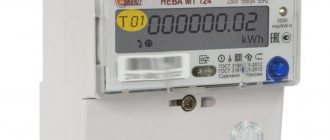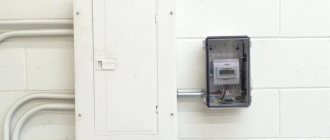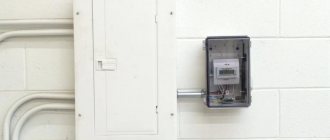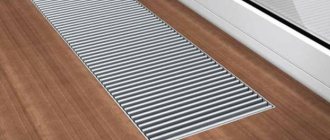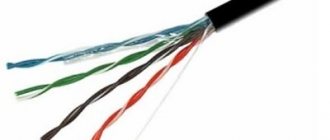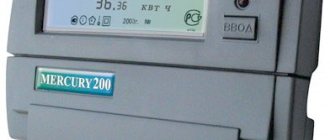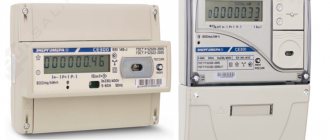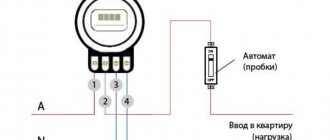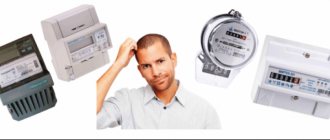- April 18, 2020
- Electricity
- Anna Gorbenko
Installing an electric meter is an inevitable moment for any owner of an apartment, studio, office space, production workshop, warehouse, etc. If you are a consumer of electricity (whatever its direct purpose may be), one way or another you will have to install an electric meter. Otherwise, you risk being subject to serious penalties, the amount of which will unpleasantly surprise you.
Problem of choice
When it comes to installing a metering device in an apartment, some users are perplexed. Which one to choose: single-tariff or multi-tariff meter? What is the difference? Which one is considered optimal and for which networks is it suitable? All these questions seem too complicated at first. And to answer them, you need to understand the fundamental essence of these devices and make some preliminary calculations.
Are there any additional costs
There are, of course, additional costs in relation to a multi-tariff metering device. They will occur even when repairs are not required. The first cost item will be the fact that to program such a meter, a separate team must come and charge a considerable fee for this. For each individual tariff, you must enter your data and conditions for its validity. If electricity tariffs change, it will have to be reprogrammed, which may be at the user’s expense. Each electrical device has a calibration interval. When it is reached for a three-tariff meter, it will have to be dismantled and given to the appropriate service. How accounting will be carried out during his absence is determined by the management company.
Note! The memory inside electric meters is volatile. To prevent data loss, batteries are included in the design
Over time, they fail and require replacement. Such maintenance will cost not only the cost of batteries, but also the cost of calling a team for work.
Differences
The fundamental difference between single-tariff and two-tariff electricity meters is, in fact, visible from the definition itself. But this is not enough.
Before purchasing, it is fundamentally important for many users to understand how a multi-tariff meter differs from a single-tariff meter, and which meter to choose would be more correct, based on the conditions for using the energy resource.
And this is an absolutely rational position, because knowledge of any nature is a powerful tool thanks to which you can get what you want and not worry about missed opportunities. This is why it is really important to learn about the features of different models of accounting devices before purchasing one of them.
How to choose
Standard single-tariff electricity meter There are three types of meters for monitoring electricity consumption. The first is a well-known single-phase standard meter that measures volume as it is used.
It is designed in such a way that the controllers can only take into account the total amount of electricity wound.
New two-tariff and three-tariff meters are designed in such a way that they calculate and index the kilowatts used at different programmed periods of time.
Multi-tariff electricity meter This means that it records data day and night separately from each other, allowing you to set a separate tariff for each time period.
It’s difficult to answer which type to choose, because each has its own advantages and disadvantages. But it should be remembered that these innovations pay off well if a large amount of energy is used.
For example, apartments and houses that use electric heating or small industrial premises will pay for the cost of the device and will save faster and more than ordinary residential premises that use electricity only for domestic needs in small quantities.
You may be interested in an article about single-phase electricity meters.
Read the article about two-tariff single-phase electricity meters here.
Characteristic features of single-tariff devices
Single-tariff devices read information about the consumed amount of electricity consumed at a single established tariff. It “winds up” kilowatt after kilowatt at a clearly established fixed rate for each of them, without switching from one built-in meter to another.
The very principle of calculating energy consumption in this regard is similar to the good old induction meters. Unless they worked due to magnetic fluxes and an aluminum disk inside the device, and electronic models reflect information directly on the indicator board.
But their similarity lies in the fact that every day the user consumes electricity and knows that at the time of paying for the services of the energy sales company, he will simply need to multiply the “inflated footage” of a kilowatt by a specific tariff established within the framework of the state pricing policy for this resource.
Advantages and disadvantages
During operation, a two-tariff electricity meter calculates the kilowatts consumed from 07:00 in the morning to 23:00 in the evening at the regular tariff, and in the period from 23:00 to 07:00 in the morning it is half cheaper. Therefore, the main benefit of such an electricity meter will make itself felt when the equipment operates at night. The main advantages of using two-tariff models include:
- Saving money – the main advantage for the population is the opportunity to save money on paying bills. Despite the fact that installing a two-tariff electricity meter requires the consumer to purchase an electrical energy meter, it will pay for itself within 1 to 2 years of active operation.
- Load redistribution - in view of the opportunity to pay less, residents, as a rule, try to turn on the most powerful equipment after 23:00. At the same time, set the maximum mode for electric heating systems, start the washing machine or bread maker. There are quite a lot of options for implementing two-tariff consumption and each person should consider the possibility of its implementation on an individual basis.
- Reducing the likelihood of power shortages during peak periods of consumption - on the scale of a village, city or specific power plant, load redistribution will avoid voltage sag and system overload. Which, in turn, will affect the quality and durability of electrical appliances.
- Reducing the number of electrical equipment overloads at transformer substations. This will reduce the frequency of emergency shutdowns, the time to restore normal operation of the system, and the de-energization of consumers during emergency response.
But, in addition to the advantages of using two-tariff electricity meters, there are also some disadvantages. Thus, real savings are possible only for those consumers who are able to ensure night operation of electrical equipment. Otherwise, a two-tariff electricity meter may not pay off.
It should also be noted that not all cities and regions can use a two-tariff system of payment for consumed electricity. Since this function is regulated at the state level, the preferential price can be canceled at any time, especially since the issue has already been raised. When using an inflated daily tariff in some regions, the result of savings can be reduced to 10 - 15%. Therefore, before installation it is necessary to calculate the feasibility of such a replacement.
Description of multi-tariff devices
Multi-tariff (multi-zone) installations are somewhat more complicated. The key point of such devices is that the energy consumed is distributed over specific time intervals. What is it for?
The thing is that energy sales companies set different tariffs for the use of electricity at different times of the day. There is daytime and there is nighttime. There is a “peak” time, when the majority of the region’s population returns from work and massively loads the electrical networks, and there is a “half-peak” time, when much less electricity is consumed.
In other words, the purchase of a multi-tariff device with the correct temporary consumption of electricity allows the owner to save money.
Application of three-tariff electricity metering devices
You can achieve even greater savings if three-tariff meters are used. When metering energy, three temporary tariffs are used. You can save a lot especially when consuming large amounts of electricity.
Modern multi-tariff systems use differentiated metering by time of day. For such electricity metering, a three-tariff electricity meter is used. In addition to night and day, the time interval for the peak load of the power system is also allocated.
This is from 7.00 to 10.00 and from 17.00 to 21.00, an increased tariff is applied here, so in Moscow it is 6.46 rubles / kW and the half-peak zone is from 10.00 to 17.00 and from 21 .00 to 23.00. The identification of these zones should encourage consumers not to turn on household appliances during peak load periods.
With the constant increase in the cost of electricity, it becomes clear that using single-tariff meters is not as profitable as three-tariff meters.
However, our mentality is difficult to change. Must be willing to use electrical appliances at night. For this purpose, tariffs have been introduced that can stimulate the population to make maximum use of electricity in the T2 zone.
The three-tariff meter also imposes restrictions on the use of electrical appliances during peak loads of the power system. This is intended to reduce the maximum load on the power lines, which will reduce losses and reduce the load on the generator.
This achieves fuel savings and improves the environmental situation in the country. In addition, the service life of switching equipment and power lines is increased. Despite the obvious advantages, before using three-tariff electricity meters in the presence of a 3-phase network.
You should carefully calculate the available loads and how they are used during the day. To do this, it is necessary to make statistical measurements of the readings of existing metering devices, and then make calculations.
They will show, if you install the appropriate electric meter, how effectively 3rd tariff metering can be applied. Such electrical devices are especially effective when leading a nocturnal lifestyle. Or constant control over the use of electricity. Turn on electrical devices according to the established schedule.
So, if you have a storage boiler for hot water, it can be programmed to turn on at 5 am, and at 7 am you will already have hot water. Without spending an expensive tariff on basic heating.
Types of multi-zone metering devices
All multi-zone devices are divided into two- and three-tariff.
- The first ones work due to the possibility of setting two modes: night and day. During the night time interval from 23:00 to 7:00, tariffing is carried out with the introduction of a 50% rate, while during the day it is a 100% payment.
- The latter work by setting three modes: night time, “peak” and “half-peak”. At night, a coefficient of 0.4 of the standard tariff is introduced, during “peak” hours (from 8:00 to 11:00 and from 20:00 to 22:00) a coefficient of 1.5 is applied, at the rest of the time (“half-peak” ) – this indicator is 1 (payment at the standard rate).
Which company's electricity meter should I choose?
Among the numerous manufacturers of electricity metering devices, experts do not recommend all of them. The TOP 5 best companies of 2022 included:
- Typeit. The company entered the market almost 20 years ago and since then has consistently been among the best sellers of various electrical equipment. Today Taipit is an exclusive distributor and part-time developer and manufacturer of electrical installation devices that meet all modern technical requirements.
- Energy meter. One of the key leaders in the domestic market, Energomera has been producing a wide range of products for more than 25 years, which it sells in Russia and the CIS countries. The company owns 4 factories and 1 scientific institute of electrical instrument making. The brand's products have earned a good reputation for quality and a minimal percentage of defects.
- INCOTEX. The company is the largest domestic developer and manufacturer of unique electrical equipment. The brand’s assortment includes more than 800 product items, which are actively sold on the world market. The company gained popularity for its regular implementation of modern technologies, which make technical devices in demand from year to year.
- ABB. The international brand produces over 70 million types of various electrical products. ABB delivers to 100 countries around the world; the company not only produces, but also fully services its products.
- I.E.K. The large and progressive company IEK produces high-quality electrical products; the brand's factories are located in the Tula region and in Moldova. In 2022, the popular manufacturer provides a wide range of high-quality equipment and components, completely covering the needs of customers.
Advantages of multi-tariff devices compared to single-tariff devices
Electricity consumption in residential buildings often experiences significant daily changes. This is due to the fact that nighttime energy consumption will in any case be minimal compared to daytime for obvious reasons: everyone sleeps at night. In the morning, when everyone is getting ready for work, electricity consumption jumps again, and in the afternoon, when virtually everyone is at work, this figure drops again. Naturally, upon returning home in the evening, people begin to cook dinner, clean the house, watch TV, charge their gadgets - all this requires serious consumption of electricity. And all these moments inevitably lead to significant fluctuations, which is why neutral, “peak” and “half-peak” moments in the use of energy resources appear.
The advantages of multi-zone devices for metering consumed electricity lie precisely in the fact that these intervals can be controlled. The multi-tariff meter stands out against the background of single-tariff devices with the following winning points:
- The ability to connect three-phase household appliances - a standard single-phase electric meter may sometimes not be enough for devices such as, for example, an electric boiler for heating water (water heating boiler), electric stove, electrically driven appliances, etc.
- Possibility of preventing phase imbalance resulting from electrical overload. Single-tariff single-phase electricity meters do not have this function. Multi-tariff installations tend to connect those devices that do not function at low voltage.
- The ability to distribute the load evenly and rationally, selecting the appropriate phase for each device.
- Possibility of increasing power consumption if necessary.
- Reducing the rated current of the protection device located in the distribution board. This, in turn, increases the level of safety in using electricity.
- Preservation of indicators throughout the entire life of the device. Agree, it is very convenient if payment receipts are lost to have the data recorded in the device.
- Significant savings in electrical energy at night and during off-peak times. When consuming electricity at night, you will have the opportunity to pay for the services of the energy supply company in an amount reduced by 4 times compared to the daytime tariff. In "half-peak" zones you will be able to save a quarter of your daily budget.
Two-tariff and three-tariff systems
Today, there are three types of electricity metering devices in use, designed for a specific system. There are different types of accounting systems:
- single-phase - the price for electricity consumption is the same at any time of the day,
- two-phase - time days are divided into two zones, and the price for electricity consumption depends on the time of use,
- three-phase - the day is divided into three zones, and the price for electricity consumption depends on the time of use.
It is easier to pay for electricity using a single-phase meter, but using two- and three-phase devices can significantly reduce costs. Let's look at them in more detail.
Two-tariff system
If a double electricity tariff is applied, then the time in the day is divided into two zones, for which different payments are provided. Day zones with a two-tariff system:
- day,
- night.
Payment for night time use is lower than for daytime use. Readings on this meter are transmitted according to two indicators, usually T1, T2. However, the designations may be different, since they depend on the software installation of the meter itself.
Three-tariff system
When using a three-phase system, the temporary day is divided into three zones, for which different payments are also provided. Day zones with a three-tariff system:
- peak,
- half-peak (daytime),
- night
Electricity tariffs for the day, night and half-peak are meant to be different, and if you use powerful household appliances in the “cheapest” zone, you also get good money savings.
Flaws
However, like any other electronic device, multi-zone meters have their drawbacks.
- Firstly, any three-tariff or two-tariff electricity meter is more expensive than a single-tariff one. This is due to the more complex structure of the structure.
- Secondly, installing such a device is more troublesome than placing a simple electronic meter in an apartment. You will have to coordinate the installation of a specific device with the energy sales inspectorate and program it correctly.
- Thirdly, the benefits of such devices are very relative and are significant under certain conditions. For example, if you do not consume electricity at night and are not going to adjust the performance of energy-consuming devices at night, then there is no point in installing such a meter.
Single-phase, three-phase, maximum current
The question of which meter to install—one-tariff or two-tariff—may not be the only one. Most city apartments or private houses are connected to a single-phase 220 V network with a frequency of 50 Hz. These are the indicators that the counter should meet. However, there are also connections to a three-phase network. This usually becomes necessary in apartments or private houses with electric heating or stationary electric stoves. In this case, special sockets and plugs are installed in the house, on more powerful cables.
If you have a three-phase connection, you will have to purchase a corresponding meter. Some three-phase meters can be connected to a single-phase network, which greatly expands their versatility.
In addition, for each meter, parameters such as rated and maximum load current are determined. As a rule, they are designed for a maximum permissible value of 60 A, which corresponds to 10 kW. This is quite enough for most cases. However, if the total load can exceed 10 kW, then you should purchase a meter with a maximum current value of 100 A. Typically, such devices are connected directly to the network without the use of additional converters.
All these indicators are indicated on the front panel of the device or in its technical data sheet.
Comparative analysis
So which meter should you choose: multi-tariff or single-tariff? Which is more profitable? And is it possible to use a multi-tariff meter as a single-tariff device?
Let's summarize:
- Multi-zone devices are considered less reliable than single-tariff devices.
- For a multi-tariff meter you will have to pay more upon purchase.
- Single-tariff devices are simpler in design; therefore, their operation also does not require problems with adjustment to the time schedule.
- Switching multi-tariff devices to winter and summer time requires money and time.
- Multi-zone meters have a higher accuracy class (they minimize error rates when calculating consumed kilowatts).
- Multi-tariff devices are much more profitable for residents of large private houses or apartments, in which the main electricity consumption is distributed at night.
In purely practical terms, using a multi-tariff device instead of a single-tariff device is quite possible. The question is expediency: what is the point of overpaying when buying for a device? And besides, payment at tariffs for it subsequently, depending on the specific region, may exceed the single tariff.
Do you need it? Hardly. Moreover, such a procedure must be approved by an energy sales inspector, otherwise this installation will not be considered legal if such a meter model is not on the list of approved ones.
Accuracy class
The indicator displays the possible error of the device and is expressed as a percentage. Induction meters in most cases had a class of 2.5. Whereas electronic devices usually have a higher class - 2, 1, 0.5 and higher, regardless of whether you choose a single-tariff or double-tariff electricity meter.
The accuracy class can be viewed both on the device itself and in the technical documentation. Usually it takes the form of a pictogram in the form of a number enclosed in a circle.
Obviously, the higher the accuracy class, the more expensive the device. And here it is necessary to understand one more important subtlety. Often, electrical network workers require the purchase of a device with high accuracy, for example, 1 or even 0.5. This is not justified; there is government decree No. 442 of May 4, 2012, which determines that accuracy class 2 or higher is established for private consumers in apartment buildings or private buildings. Class 1 is only required if the system load is above 670 kW, which is practically impossible under such conditions.
The same decree states that if there is an installed measuring device with a lower accuracy class, then it must be replaced only after the test interval has expired or it has failed. Thus, workers' demands to replace the meter with a more accurate one are illegal.
Who is a multi-zone meter suitable for?
If you actually do not consume electricity at the time of tariff reduction (that is, at night), such a meter will pay for itself within several years. Therefore, you hardly need such a device in your apartment.
If you have an electric boiler, a water heating boiler installed in your house, there are various electric heating devices, and heated floors are installed under the tiles, you will pay for a multi-zone meter in the first few months. To speed up its payback, it is recommended to switch the operation of the washing machine, dishwasher, multicooker and other programmable equipment to night mode. This will save you extra money.
Factors determining product selection
Before you go to the store and purchase multi-tariff electric meters that are suitable for you, you should clearly decide which model is suitable for your apartment or country house. This is usually based on the following factors:
- type of supply voltage (single-phase or three-phase power supply);
- number of tariff regimes;
- the presence of additional functions in the purchased multi-tariff meter (overvoltage protection, for example).
In ordinary city apartments, as a rule, standard single-phase meters are used, while in private suburban households a 3-phase model of the device may well be in demand, providing accounting for electricity consumption in power supply circuits. Regarding the choice of the number of tariffs, many consumers focus on 3-tariff devices, which provide a flexible approach to planning upcoming electricity costs. Well, the possibility of purchasing a product with advanced functionality depends on the financial capabilities and preferences of each individual user.
How to install a multi-zone meter
To connect a multi-tariff electricity meter, you need to carry out a list of certain actions.
- Submit an application to the energy sales company for the installation of a multi-zone device - they will select the appropriate model for you.
- To purchase a device and program it, you need to contact a specialized company to which your electricity supplier will refer you.
- Set an installation date - the service organization will record the call and arrive at the agreed time.
Connecting two-tariff metering devices
What a two-tariff meter is is well known to residents of new buildings, because almost all newly commissioned houses are equipped with such multi-tariff electricity meters.
If not, consumers, when replacing the electric meter again, can write a statement to Gosenergonadzor and the energy distribution company in their region about their desire to change the metering equipment. The connection must be completed by specialists from the energy organization within 24 hours. As a rule, many energy companies perform the entire range of work (at the consumer’s request): they purchase two-tariff meters, install them, configure them and provide subsequent warranty service.
However, all these operations can be carried out on their own if the homeowner has an idea of how to connect electrical equipment. To do this, you must first thoroughly study the instructions and circuit diagram for switching on the meter, which are included with the equipment set by its manufacturers. First of all, you need to take care of safety, for which you turn off the switch or traffic jams. If the input cable is supplied directly to the meter, the entire line must be de-energized. When installing the metering device, it is necessary to observe the correct order of contacts, taking into account the requirements of the Electrical Installation Rules.
All work is divided into the following stages:
- removal of the previous counter;
- installation of a new two-tariff unit;
- testing the software of a new device and programming it in accordance with existing tariff plans;
- setting up and checking network connection;
- sealing the device.
Important! In the future, in order to avoid fines, it is very important to maintain the integrity of the seal.
The best two-tariff meters
If you have already decided which meter to choose - single-tariff or multi-tariff - and your choice still fell on the second option, you will definitely want to know which specific model is recognized by users as the best and what you should focus on. Among the multi-zone models, there are optimal options - both dual-mode and three-mode.
When wondering which two-tariff electric meter is best to choose for your home, pay attention to two main models, approved by both specialists and users:
- ABB FBB 11205-108. Country of origin: Sweden. Average cost – 6500 rubles. The current strength is designed for a range of 10-80 A. The program has a built-in clock indicating the date and time. You can switch tariffs according to a designated schedule. The meter can be installed very quickly thanks to the convenient mounting rail. The device is reliably protected from moisture and dust.
- "Lenelectro LE 221.1.R2.P2.5". Country of origin: Russia. Average price – 1116 rubles. This, perhaps, attracts buyers many times more than the characteristics themselves. And they are quite good on the device. Easy-to-set up programming makes it possible to configure the device in such a way that it fully complies with the tariff schedule of the corresponding region. You will install this device completely free of charge (which is important) and forget about problems with it for at least 30 years. Reviews about Lenelectro multi-tariff electricity meters are mostly positive.
Selecting a meter, its cost and installation
You can purchase an electrical energy meter at any electrical goods store. Sales consultants will tell you what a two-tariff meter is, which ones are good, and give advice on choosing an electronic device. The cost of equipment depends on the manufacturer, model, accuracy class and service life.
A brief overview of budget electronic (static) electricity meters.
| № | Name | Manufacturer country | Accuracy class | Warranty period, years | Service life, years | Average price, rub.* |
| 1 | TAIPIT NEVA MT 124 AS OR 1ph 5-60A 220V | Russia | 1 | 7 | 30 | 2660.00 |
| 2 | INCOTEX MERCURY 206 RN 1ph 5-60A 1.0/2.0 | Russia | 2 | 3 | 30 | 2400.00 |
| 3 | ENERGOMERA 459547 CE 102 R5.1 145 J 1ph 5-60A | Russia | 1 | 4 | 30 | 1550.00 |
| 4 | SOE-55/50Sh-T-112 MZEP | Russia | 1 | 3.5 | 32 | 1450.00 |
*According to the website https://lipetsk.220-volt.ru.
- TAIPIT NEVA MT 124 AS OR 1ph 5-60A 220V.
- INCOTEX MERCURY 206 RN 1ph 5-60A 1.0/2.0.
- ENERGOMERA 459547 CE 102 R5.1 145 J 1ph 5-60A
- SOE-55/50Sh-T-112 MZEP.
More expensive two-tariff meters with advanced functionality are also sold, but not always expensive ones with many functions that are much better than usual. Still, the main task of the device is to correctly record data.
Before purchasing, you should pay attention to the accuracy class, verification time and the availability of additional maintenance for a multi-tariff meter.
The best three-tariff meters
According to experts and users, the best multi-tariff electricity meters operating in three time modes (three-tariff) are represented by two optimal domestic models:
- "INCOTEX MERCURY 201.8". Country of origin: Russia. The average cost ranges from 600 to 700 rubles. Liquid crystal display, unpretentiousness, operability at high humidity (90%) and low temperature (minus 45 degrees), as well as a modular housing and measuring transducer - all this causes only flattering responses from meter users.
- "Energomera CE 101 S6". Country of origin: Russia. Average cost – 650 rubles. It is placed under a single-phase network, works stably, retains readings even in the event of electrical wiring failures, is not afraid of moisture, low temperatures, has a 5-year warranty and a promised service life of more than 30 years.
Industrial models
The multi-tariff electricity meter “TsE 2726-12” (manufactured by the Leningrad Electrical Mechanical Plant) is installed in single-phase electrical circuits. This electronic device provides control of consumed electricity with a breakdown of the operating period not only by time of day, but also by day of the week. It should also be noted that the electrical device “TsE 2726-12” provides protection of power circuits from sudden changes in current and voltage.
The line of multi-tariff electric meters “MTX Matrix” produced by Takko LLC, Kharkov, includes both single-phase (1A10) and 3-phase devices (3G, 3R30, 3R05). All products of this brand are highly versatile, allowing you to take readings not only directly from the device display, but also use them as part of special automated control systems (ASCAE). In such systems, data on electricity consumption can also be sent to the central console via special wireless communication channels.
In conclusion, we note once again that the transition to multi-tariff metering of consumed electricity contributes to more efficient use of electricity and allows you to save on paying electricity bills.
Tariffs in the Moscow region for apartments and houses in rural areas
| 01.01.2020 30.06.2020 | 01.07.2020 31.12.2020 | |
| Single-tariff accounting using a single-rate tariff | 3,89 | 4,01 |
| Two-tariff metering using a tariff differentiated by day zones | ||
| night zone T2 (23.00-7.00) | 1,68 | 1,76 |
| day zone T1 (7.00-23.00) | 4,47 | 4,61 |
| Multi-tariff metering using a tariff differentiated by day zones | ||
| night zone T2 (23.00-7.00) | 1,68 | 1,76 |
| half-peak zone T3 (10.00-17.00; 21.00-23.00) | 3,89 | 4,01 |
| peak zone T1 (7.00-10.00; 17.00-21.00) | 5,06 | 5,21 |
| from 01.01.2020 to 30.06.2020 | from 07/01/2020 to 12/31/2020 | |
| Indicator (consumer groups broken down by rates and differentiated by day zones) | Price (tariff) in rub./kWh | Price (tariff) in rub./kWh |
| 1. Urban population | ||
| Peak zone T1 07:00 - 10:00; 17.00 - 21.00 | 7,23 | 7,45 |
| Half-peak zone T3 10:00 - 17:00; 21.00 - 23.00 | 5,56 | 5,73 |
| Night zone T2 23:00 - 07:00 | 2,41 | 2,52 |
| 2. Population living in houses equipped with stationary electric stoves | ||
| Peak zone T1 07:00 - 10:00; 17.00 - 21.00 | 5,06 | 5,21 |
| Half-peak zone T3 10:00 - 17:00; 21.00 - 23.00 | 3,89 | 4,01 |
| Night zone T2 23:00 - 07:00 | 1,68 | 1,76 |
| 3. Population living in rural settlements and equivalent to them | ||
| Peak zone T1 07:00 - 10:00; 17.00 - 21.00 | 5,06 | 5,21 |
| Half-peak zone T3 10:00 - 17:00; 21.00 - 23.00 | 3,89 | 4,01 |
| Night zone T2 23:00 - 07:00 | 1,68 | 1,76 |
| 4. Consumers equal to the population | ||
| Peak zone T1 07:00 - 10:00; 17.00 - 21.00 | 7,23 | 7,45 |
| Half-peak zone T3 10:00 - 17:00; 21.00 - 23.00 | 5,56 | 5,73 |
| Night zone T2 23:00 - 07:00 | 2,41 | 2,52 |
On the official website of Mosenergosbyt, in the tariffs and payment section, six menu items are presented: “Tariffs for Moscow”, “Tariffs for the Moscow region”, “Methods of payment for electricity”, “Information for the population about payments for electricity taking into account common household needs (ODN)”, “Benefits” and “Information on the value of the established social norm for the consumption of electrical energy (power) for the population”, in turn, in the “Tariffs” section there is a description of electricity tariffs in force in Moscow and the Moscow region, by clicking on the section with tariffs you need, you You will be able to familiarize yourself with them in more detail to calculate your electricity costs.
Based on this pricing, Mosenergosbyt provides electricity tariffs broken down by rates and day zones, based on the individual needs of its subscribers. There are one-, two- and multi-tariff charging systems. With a multi-tariff system, not only daytime and nighttime electricity consumption is taken into account, but also its peak hours.
Electricity for common house needs (GDN) and its calculation.
In the section “Information for the population about payments for electricity taking into account common building needs (CDN)” you can familiarize yourself with a detailed diagram of electricity costs in an apartment building.
The rules for the provision of utility services are reflected in Resolution No. 354 of the Government of the Russian Federation dated May 6, 2011 (as amended on February 27, 2017) “On the provision of utility services to owners and users of premises in apartment buildings and residential buildings.”
In addition to paying for individual electricity consumption, residents also need to pay for general house needs (CHN). Such amounts are calculated, accrued and allocated in the payment receipt separately from each other.
Payment for communal electricity in an apartment building is mandatory for everyone, does not depend on whether consumers have individual metering devices (IMU) and is proportional to the area of the premises they occupy.
If there is a common building meter, the volume of electricity supplied to the unit, subject to payment, is calculated by subtracting the total volume of individual consumption in all premises of the apartment building from the readings of the common building meter.
If a common house electricity meter is not installed, then the calculation of charges is carried out according to current standards.
Privileges
The “Benefits” section will help you apply for, extend or re-register a benefit for paying for electricity at Mosenergosbyt PJSC. There are several ways to implement this:
- In LKK in the “Benefits” section;
- Apply through Video Consultant. Video communication terminals installed in multifunctional centers (MFCs).
- From the operator at the nearest branch of Mosenergosbyt PJSC.
According to the law of the Russian Federation, benefits on electricity payments are provided to the owner for one property, apartment or residential premises.
In the same section you will find detailed information about the procedure for closing benefits and.
answers to the question “how to apply for benefits in the Moscow region.”
Apartments and houses with electric stoves
Electricity tariffs presented below in the tables for the population and equivalent categories of consumers in the city of Moscow and the Moscow region are indicated in the ratio rub./kWh
| from January 1 to June 30, 2022 | |
| Single-tariff accounting using a single-rate tariff | 3,77 |
| Two-tariff metering using a tariff differentiated by day zones | |
| night zone T2(23.00-7.00) | 1,60 |
| day zone T1(7.00-23.00) | 4,33 |
| Multi-tariff metering using a tariff differentiated by day zones | |
| night zone T2(23.00-7.00) | 1,60 |
| half-peak zone T3(10.00-17.00; 21.00-23.00) | 3,77 |
| peak zone T1(7.00-10.00; 17.00-21.00) | 4,90 |
Tariffs are inclusive of VAT.
Electricity tariffs do not include commission fees charged by credit institutions and payment system operators for services for accepting this payment.
| from July 1 to December 31, 2022 | |
| Single-tariff accounting using a single-rate tariff | 3,89 |
| Two-tariff metering using a tariff differentiated by day zones | |
| night zone T2(23.00-7.00) | 1,68 |
| day zone T1(7.00-23.00) | 4,47 |
| Multi-tariff metering using a tariff differentiated by day zones | |
| night zone T2(23.00-7.00) | 1,68 |
| half-peak zone T3(10.00-17.00; 21.00-23.00) | 3,89 |
| peak zone T1(7.00-10.00; 17.00-21.00) | 5,06 |
Tariffs are inclusive of VAT.
Electricity tariffs do not include commission fees charged by credit institutions and payment system operators for services for accepting this payment.
TOP 2 three-phase electricity meters
These devices are used where there is high power consumption. They have high power and a complex design; the flow rate is measured very accurately. The maximum network voltage is 380 V.
2No2. LEMZ TsE2727U
The device is resistant to various types of influence (such as electromagnetic radiation, weather, mechanical), and is also characterized by high ease of use. The maximum load is 100 A. Note that the software provides very great capabilities: it not only keeps track of energy, but also controls operating modes, and is responsible for storing information and transmitting it.
pros
- long service life;
- 8 tariffs supported;
- high degree of protection;
- the presence of a fuse that prevents the theft of electricity.
Minuses
- Setting up tariffs is quite difficult.
Prices for LEMZ TsE2727U
LEMZ TsE2727U
1No1. Lenelectro 3.D1 1.0.A
A device with an accounting log and control of a number of parameters provided by the manufacturer (these include current, frequency, phase power, etc.). We also note that the accuracy class corresponds to the 2nd, the display displays various useful information. Thanks to archiving, you can store information for the last 3 years.
pros
- low cost;
- logbook;
- accurate readings;
- The display is very informative.
Minuses
- difficulties with the initial setup of the model.
Prices for Lenelectro 3.D1 1.0.A
meter Lenelectro 3.D1 1.0.A/s>
